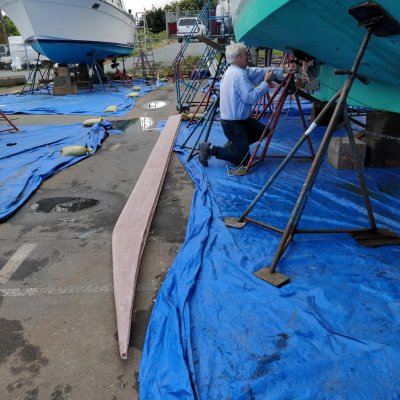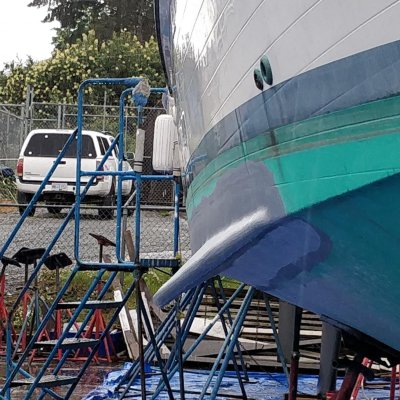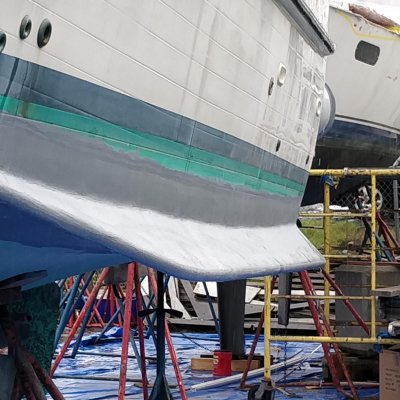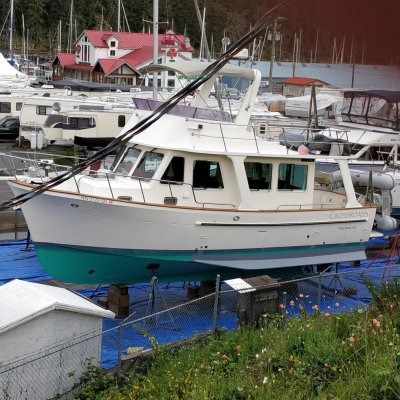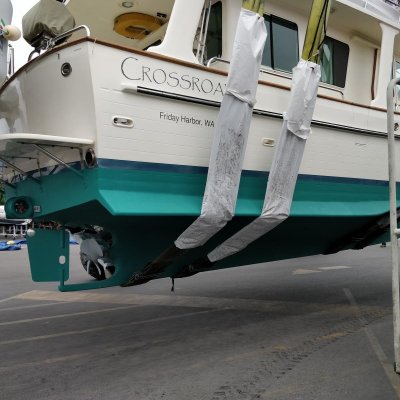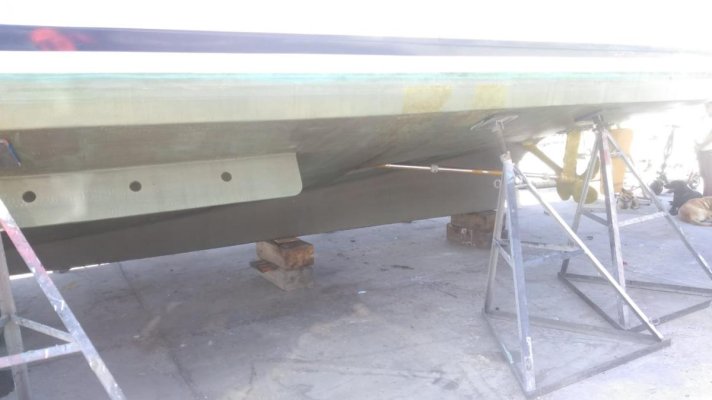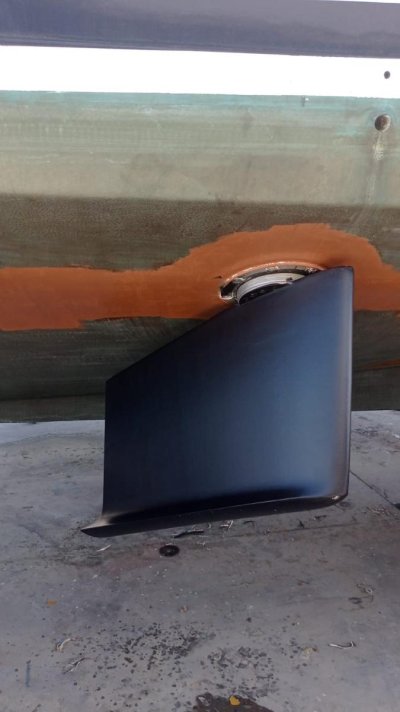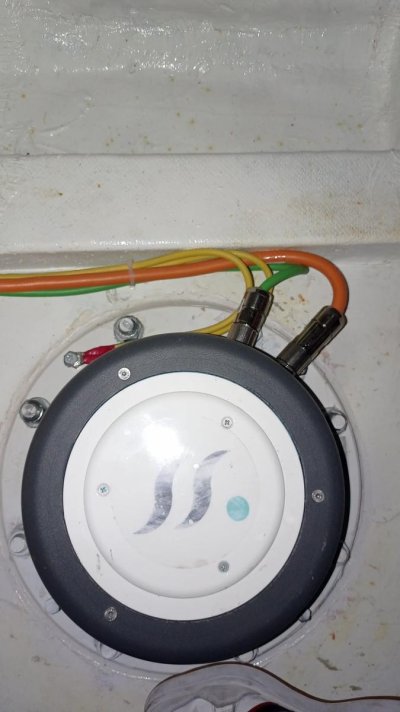You are using an out of date browser. It may not display this or other websites correctly.
You should upgrade or use an alternative browser.
You should upgrade or use an alternative browser.
Stabilization for a GB32
- Thread starter GB32Patience
- Start date
The friendliest place on the web for anyone who enjoys boating.
If you have answers, please help by responding to the unanswered posts.
If you have answers, please help by responding to the unanswered posts.
kapnd
Guru
- Joined
- Aug 31, 2013
- Messages
- 880
- Location
- usa
- Vessel Name
- #31
- Vessel Make
- ex-Navy MUB 50 fish/cruise
Roll control on smaller boats is indeed a quandary.
Any solution available is going to be some kind of trade-off, costing speed, fuel, and dollar$.
I’ve tried rolling chocks, birds(best) and bilge keels, none being very effective, and certainly not worth what they cost me!
Current boat has a heavy filled 2/3 keel, and a ton of lead in the bilge.
Though it does roll, the motion is fairly slow and predictable, and I’ve decided I can live with it.
The ballast bag idea is interesting, you could belt it about the middle for an adjustable pinch point, or just slide pieces of lumber under the middle as an adjustable dam.
Don’t forget that the supporting structure needs to be strong enough, not only for the direct weight, but the increased racking forces too, and then the bag should be adequately secured in place as well.
Any solution available is going to be some kind of trade-off, costing speed, fuel, and dollar$.
I’ve tried rolling chocks, birds(best) and bilge keels, none being very effective, and certainly not worth what they cost me!
Current boat has a heavy filled 2/3 keel, and a ton of lead in the bilge.
Though it does roll, the motion is fairly slow and predictable, and I’ve decided I can live with it.
The ballast bag idea is interesting, you could belt it about the middle for an adjustable pinch point, or just slide pieces of lumber under the middle as an adjustable dam.
Don’t forget that the supporting structure needs to be strong enough, not only for the direct weight, but the increased racking forces too, and then the bag should be adequately secured in place as well.
AKDoug
Guru
Roll chocks are as common as grass on lawns on the small fishing boats here in Alaska, I am sure they wouldn't bother if the reviews from their fellow fishermen weren't positive. You very seldom see a commercial fishing boat under 45' that doesn't have them installed.
ofer
Guru
- Joined
- Apr 10, 2020
- Messages
- 530
- Location
- USA
- Vessel Name
- Unicorn
- Vessel Make
- 1970 50' DEFEVER OFFSHORE CRUISER Timber
Roll chocks are as common as grass on lawns on the small fishing boats here in Alaska, I am sure they wouldn't bother if the reviews from their fellow fishermen weren't positive. You very seldom see a commercial fishing boat under 45' that doesn't have them installed.
I am in Homer boat yard and most of the fishing fleet has replaced their paravanes with rolling chocks. Not because birds don't work its just too much trouble while fishing etc.
I just bought a used set and installed it on my trawler, will be tested next week.
GB32Patience
Senior Member
- Joined
- Oct 29, 2020
- Messages
- 117
- Vessel Name
- Patience
- Vessel Make
- 1978 GB 32 Sedan
Hey @ofer! Please post any photos if you have! Thanks!
GB32Patience
Senior Member
- Joined
- Oct 29, 2020
- Messages
- 117
- Vessel Name
- Patience
- Vessel Make
- 1978 GB 32 Sedan
@Ofer I see now your reference is to the birds you purchased. Actually interested in the rolling chocks locally if any references available. Thanks!
Crossroads
Senior Member
I'm late to this party, but since our boats are similar, I'll off our experience with rolling chocks.
In our experience your NA's estimate of 35% reduction is conservative, but close. With large wakes the roll is attenuated and the number of rolls is reduced, usually to one or two. No more pendulum effect. In nasty 3-4' short chop like last week in Georgia Strait, the boat is going to move, but less than without chocks.
When I showed up at the yard, the chocks had been prefabbed and we're waiting. Installation took 2 1/2 days plus two days for cure then bottom paint. In and out of the yard in five days. Total cost including yard was around $6500 with me supplying paint.
There were two options: 12" and 18". We chose 12", mostly to avoid side interferences, but now I see that as a very unlikely issue. 18's would have been shorter overall.
Haul out slings have never been an issue with our installer, who has done "hundreds", mostly fishboats. The majority of the boats load is taken by the keel and loads on the chocks are primarily normal to the hull, in compression. They are stout.
I've noticed only a negligible reduction in slow speed turning ability, but we've got fore and aft cheaters.
I'd do it again. There's just no room on our small boat without major surgery for active funs.
Good luck!
In our experience your NA's estimate of 35% reduction is conservative, but close. With large wakes the roll is attenuated and the number of rolls is reduced, usually to one or two. No more pendulum effect. In nasty 3-4' short chop like last week in Georgia Strait, the boat is going to move, but less than without chocks.
When I showed up at the yard, the chocks had been prefabbed and we're waiting. Installation took 2 1/2 days plus two days for cure then bottom paint. In and out of the yard in five days. Total cost including yard was around $6500 with me supplying paint.
There were two options: 12" and 18". We chose 12", mostly to avoid side interferences, but now I see that as a very unlikely issue. 18's would have been shorter overall.
Haul out slings have never been an issue with our installer, who has done "hundreds", mostly fishboats. The majority of the boats load is taken by the keel and loads on the chocks are primarily normal to the hull, in compression. They are stout.
I've noticed only a negligible reduction in slow speed turning ability, but we've got fore and aft cheaters.
I'd do it again. There's just no room on our small boat without major surgery for active funs.
Good luck!
Attachments
Crossroads
Senior Member
One data point you didn't give us is your cruising speed. That may influence your choices. Hydraulic or electric solutions will be more effective at greater speeds. Roll Chocks and ballast bags, not so much.
I Hve had to alter course to reduce or eliminate roll when crossing the Gulf of Georgia. I find that a course change of 15 to 25 degrees is usually effective, though the roll characteristics of my boat are unlikely to be exactly the same as yours. That is for wind waves. Wash, OTOH, will come at you from any direction, but is most troubling when the wake generating boat is passing you in a narrow passage where your course altering is limited. Still, taking the wash on the bow is always preferable to taking it on the beam.
I Hve had to alter course to reduce or eliminate roll when crossing the Gulf of Georgia. I find that a course change of 15 to 25 degrees is usually effective, though the roll characteristics of my boat are unlikely to be exactly the same as yours. That is for wind waves. Wash, OTOH, will come at you from any direction, but is most troubling when the wake generating boat is passing you in a narrow passage where your course altering is limited. Still, taking the wash on the bow is always preferable to taking it on the beam.
Marco Flamingo
Guru
- Joined
- Jan 7, 2020
- Messages
- 1,112
- Location
- United States
- Vessel Name
- CHiTON
- Vessel Make
- Tung Hwa Clipper 30
I looked at the available ballast bags, but couldn't find any that were long enough. The other problem would be that they are round. I didn't know this would be a problem when I made my bag and just happened to make it a "flat bag." It lays on the FB deck about 20 inches wide and three or four inches thick when filled. No air. I can watch the water glug back and forth (actually, it doesn't glug because no air. It is amazingly silent).
My wife thought that the roll bag increased the boat's fore and aft pitching. Nope, but when now encountering a wake from the side, the most noticiable effect is the fore/aft pitching as we go over the wake. It's not increased. It's just that without the slamming from side-to-side the fore/aft pitch is what gets noticed. I'll take that noticeable rocking horse ride over the previous bell ringing, coffee spilling side roll. Which brings me back to the commercially available round ballast bags. After one of our open crossings I went up to the FB and found that my "flat" bag had rolled over. There was enough fore/aft pitching to move it. A round bag would definately have to be strapped in place. Probably a good idea for my flat bag, but I think I'll modify it first.
Unlike stabilizers and fins, the ART damping effect takes place at a different time in the roll. With stabilizers and fins, when the vessel is momentarily paused at the maximum roll, there is no stabilization effect. Both paravanes are doing nothing because there is no force on them (other than the always present drag from moving forward). Fins are also doing nothing at this point. As the vessel rolls back towards center, that movement results in force applied to the paravane/fin by the water trying to move past them. I'm not sure when the most force is applied to the paravane or fin, but I would think toward the center of the vessel's "pendulum" movement. In an ART that is timed right, the water sloshes to the low side a fraction of a second after maximum roll. So the full stabilizing force is applied earlier in the roll. Interesting to find out whether the "timing" of an anti-roll force reduces the amount of force neccessary to stabilize. It sure seems like 25 gallons of moving water wouldn't have the amount of effect it has.
Came back south around Cape Caution today but, darn it, it was glassy smooth with no swell, no chop, no wind. Didn't get any further testing in. Did get cell phone coverage. Also, it was so smooth I stopped and caught a nice ling cod.
My wife thought that the roll bag increased the boat's fore and aft pitching. Nope, but when now encountering a wake from the side, the most noticiable effect is the fore/aft pitching as we go over the wake. It's not increased. It's just that without the slamming from side-to-side the fore/aft pitch is what gets noticed. I'll take that noticeable rocking horse ride over the previous bell ringing, coffee spilling side roll. Which brings me back to the commercially available round ballast bags. After one of our open crossings I went up to the FB and found that my "flat" bag had rolled over. There was enough fore/aft pitching to move it. A round bag would definately have to be strapped in place. Probably a good idea for my flat bag, but I think I'll modify it first.
Unlike stabilizers and fins, the ART damping effect takes place at a different time in the roll. With stabilizers and fins, when the vessel is momentarily paused at the maximum roll, there is no stabilization effect. Both paravanes are doing nothing because there is no force on them (other than the always present drag from moving forward). Fins are also doing nothing at this point. As the vessel rolls back towards center, that movement results in force applied to the paravane/fin by the water trying to move past them. I'm not sure when the most force is applied to the paravane or fin, but I would think toward the center of the vessel's "pendulum" movement. In an ART that is timed right, the water sloshes to the low side a fraction of a second after maximum roll. So the full stabilizing force is applied earlier in the roll. Interesting to find out whether the "timing" of an anti-roll force reduces the amount of force neccessary to stabilize. It sure seems like 25 gallons of moving water wouldn't have the amount of effect it has.
Came back south around Cape Caution today but, darn it, it was glassy smooth with no swell, no chop, no wind. Didn't get any further testing in. Did get cell phone coverage. Also, it was so smooth I stopped and caught a nice ling cod.
North Baltic sea
Guru
Hi,
As I understand it, your system is somewhat similar to the one in the article in the link?
https://www.allatsea.net/anti-roll-tanks-a-simple-way-to-stabilize/
NBs
As I understand it, your system is somewhat similar to the one in the article in the link?
https://www.allatsea.net/anti-roll-tanks-a-simple-way-to-stabilize/
NBs
chilliwackteryx4
Member
- Joined
- Aug 7, 2022
- Messages
- 10
Have you looked at the Seakeeper 2? It’s DC powered so doesn’t require a generator as long as your main is running. Fairly small footprint and not ridiculously priced. A friend of mine works in the marine tech space and speaks highly of them. He even suggested the Seakeeper 1 (smallest size) for my Cutwater 28.
GB32Patience
Senior Member
- Joined
- Oct 29, 2020
- Messages
- 117
- Vessel Name
- Patience
- Vessel Make
- 1978 GB 32 Sedan
@Crossroads, Thanks very much for the post here. Good detail on images and nicely done installation as well. Interesting the mating edge of the chocks seems hollow, estimating to more easily match the contour of the chine. Glad to hear performance is notable. Beautiful vessel as well!
Mambo42
Guru
- Joined
- Oct 26, 2021
- Messages
- 691
- Vessel Name
- Endless Summer
- Vessel Make
- 1979 Defever 49
I had the rolling chocks (or what you call them) and they did absolutely nothing. When we were lying in the marina our boat was rocking and rolling in such a way that walking was impossible. All the other boats were lying dead quiet in the water. Out at sea in a swell or in waves we were still rolling, same was in anchorages.
It was so bad that our dogs and the admiral continuously got sea sick while being on anchor and when we were going from A to B there was no way we could do a beam course.
I looked into several options. One was selling the boat and finding a boat that handled better, by design, in the waves and winds, but that option went out of the window since we do like our Defever.
Option 2 was using flopper stoppers while on anchor, but that still did not solve the under way problem and since our boat does not have a mast, installing them became difficult.
Option 3 was to install stabilizers and yes that is a very costly affair, but in the end, when it comes down to being alone on the water or being so limited in where you can go, it became real easy.
I knew exactly what I wanted, so that made it easy. I wanted a system that could work both at anchor and underway. The system needed to be easy to maintain, not power guzzling and not dependent on a generator or a running engine to function.
In the end that meant only one system came into consideration and that was electrical fins.I selected 1 size larger than was advertised for our size, since we don't make the advised speed of 10 kts. Most stabilizers are calculated for 10 kts and we do between 5 and 7 kts.
While I write this the company is finishing up the installation of the fins. It is a job you can do yourself, I have spoken with someone in the States who did it himself (with his sons) and the fins work fine. In a couple of days we will go into the water and then I will find out whether they work as advertised. Luckily I spoke with a captain of a 45 mtr yacht last week that had to come in for emergency repair of the Stbd fin after he hit a log while underway at 20 kts. Repair was done in 3 days and so far he has been absolutely happy by the performance of the fins. Has been 7 years since they have been installed.
What do my fins use ? Between 0.5 and 2 Kw (220 V) each while underway and between 0.2 and 1 kw while on anchor. While underway I can run that off my alternators and while on anchor I can run it off the solar and the battery bank (1400 Ah at 24 V).
Is it expensive ? Yes it is very expensive and perhaps not a logical option for you, but they do make smaller fins as well, which are cheaper of course.
Another solution would be a gyro, but they do use a lot of power and thus require you to run the generator all the time. For me that was a no go, but perhaps for you that is no problem.
It was so bad that our dogs and the admiral continuously got sea sick while being on anchor and when we were going from A to B there was no way we could do a beam course.
I looked into several options. One was selling the boat and finding a boat that handled better, by design, in the waves and winds, but that option went out of the window since we do like our Defever.
Option 2 was using flopper stoppers while on anchor, but that still did not solve the under way problem and since our boat does not have a mast, installing them became difficult.
Option 3 was to install stabilizers and yes that is a very costly affair, but in the end, when it comes down to being alone on the water or being so limited in where you can go, it became real easy.
I knew exactly what I wanted, so that made it easy. I wanted a system that could work both at anchor and underway. The system needed to be easy to maintain, not power guzzling and not dependent on a generator or a running engine to function.
In the end that meant only one system came into consideration and that was electrical fins.I selected 1 size larger than was advertised for our size, since we don't make the advised speed of 10 kts. Most stabilizers are calculated for 10 kts and we do between 5 and 7 kts.
While I write this the company is finishing up the installation of the fins. It is a job you can do yourself, I have spoken with someone in the States who did it himself (with his sons) and the fins work fine. In a couple of days we will go into the water and then I will find out whether they work as advertised. Luckily I spoke with a captain of a 45 mtr yacht last week that had to come in for emergency repair of the Stbd fin after he hit a log while underway at 20 kts. Repair was done in 3 days and so far he has been absolutely happy by the performance of the fins. Has been 7 years since they have been installed.
What do my fins use ? Between 0.5 and 2 Kw (220 V) each while underway and between 0.2 and 1 kw while on anchor. While underway I can run that off my alternators and while on anchor I can run it off the solar and the battery bank (1400 Ah at 24 V).
Is it expensive ? Yes it is very expensive and perhaps not a logical option for you, but they do make smaller fins as well, which are cheaper of course.
Another solution would be a gyro, but they do use a lot of power and thus require you to run the generator all the time. For me that was a no go, but perhaps for you that is no problem.
Attachments
Last edited:
CharlieO.
Guru
- Joined
- Sep 21, 2020
- Messages
- 1,558
- Location
- Lake Champlain Vermont, USA
- Vessel Name
- Luna C.
- Vessel Make
- 1977 Marine Trader 34DC
I've seen some trawlers with big ol' trim tabs mounted. I've heard some say it does help a bit with stabilization.
rslifkin
Guru
- Joined
- Aug 20, 2019
- Messages
- 7,602
- Location
- USA
- Vessel Name
- Hour Glass
- Vessel Make
- Chris Craft 381 Catalina
I've seen some trawlers with big ol' trim tabs mounted. I've heard some say it does help a bit with stabilization.
Running at slow cruise, dropping my trim tabs partially does improve the ride a bit with no noticeable effect on speed. When I say slightly, I'm referring to lowering the tabs from just above even with the hull bottom to just below even. Further deployment doesn't make a further improvement.
Roll is slightly reduced and a little better damped with the tabs deployed and the boat gets more comfortable in pitch as well due to more damping to the motion. Roll gets slightly slower as well. It's not enough of an effect to make me stop wishing for some kind of actual stabilization though.
Jeff F
Guru
- Joined
- Nov 5, 2015
- Messages
- 2,437
- Location
- Canada
- Vessel Name
- Escapade
- Vessel Make
- 50` US Navy Utility trawler conversion
Running at slow cruise, dropping my trim tabs partially does improve the ride a bit with no noticeable effect on speed.
On my Mainship 34 MY I found the ride got much better with tabs down and more throttle. Bow down leaving a big wake was wet and fuel thirsty, but the ride was rock solid compared to a couple of knots slower.
It's worth experimenting beyond normal cruise speed to see how much it helps.
rslifkin
Guru
- Joined
- Aug 20, 2019
- Messages
- 7,602
- Location
- USA
- Vessel Name
- Hour Glass
- Vessel Make
- Chris Craft 381 Catalina
On my Mainship 34 MY I found the ride got much better with tabs down and more throttle. Bow down leaving a big wake was wet and fuel thirsty, but the ride was rock solid compared to a couple of knots slower.
It's worth experimenting beyond normal cruise speed to see how much it helps.
Oh yeah, speeding up definitely changes the ride a lot. But even at 6.5 kts the tabs do make a difference (mine are fairly large for the boat at 48x12 on a 38' boat). In some conditions the best thing to do (fuel range permitting) is to just say "screw the fuel" and get on plane. But considering how big the fuel burn penalty is for doing 17 kts instead of 6.5 - 7, we try to avoid it.
Similar threads
- Replies
- 44
- Views
- 5K

